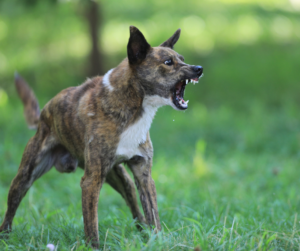Michael Baugh CDBC CPDT-KSA CSAT
Behavior does not live inside your dog. “Aggressive” is not a personality trait. It’s not a demon that lives inside your dog. In fact, sweet dogs sometimes bite. Dogs who have bitten are quite often very kind and gentle most of the time. Aggressive dog behavior, like all the things dogs do, is a response to the environment. Think of it more like a conversation. Something happens or someone does something; the dog acts; that affects the “something” or “someone” in return; the dog escalates or deescalates. Example: A person comes to your door and rings the bell. Your dog barks, charges the door, and nearly breaks the window beside it. The person, who was just dropping off a package, walks away. Your dog barks a few more times and walks away, too. Later he snuggles with you to watch Netflix.
 Change the environment to change the behavior. Of course all this is incredibly important to us. If the other beings in the dog’s environment are driving his behavior choices, then this is a huge opportunity for us. You can affect your dog’s behavior by adjusting his world even a little bit. I like to think in terms of always setting my dog up to succeed. Make it easy for him to choose the behavior we want. Example: post a note asking people to refrain from ringing the doorbell. More packages magically appear, but with do dog drama.
Change the environment to change the behavior. Of course all this is incredibly important to us. If the other beings in the dog’s environment are driving his behavior choices, then this is a huge opportunity for us. You can affect your dog’s behavior by adjusting his world even a little bit. I like to think in terms of always setting my dog up to succeed. Make it easy for him to choose the behavior we want. Example: post a note asking people to refrain from ringing the doorbell. More packages magically appear, but with do dog drama.
Teach a new pattern of behavior. This is really what we are after. Right? Don’t bark, growl, or bite. Do something else instead. That something else can be whatever we want, but it’s usually a predictable pattern of behavior. Example: when a new person comes into the home, move away and relax rather than lunge toward and bite. (That sounds reasonable to me). It’s totally teachable, especially now that people aren’t getting him all amped up by ringing the doorbell.
Teach new associations. Here’s what makes positive reinforcement dog training so amazing. When we set up the learning environment so that it’s easy for our dog to succeed and when we use salient positive reinforcement (think food) to teach new patterns of behavior, we automatically create positive associations. Example: when people arrive at the home they text rather than ring the doorbell. That allows us to put the dog in another room (setting him up for success). We then use positive reinforcement to to teach him to lie down quietly when he comes out to see the guests. There’s a new association here. Guests are less threatening and their arrival predicts food and gentle praise. We are actually teaching our dog to manage his own emotions.
Stick to the plan. We don’t cure aggressive behavior. Remember, it’s not a defective personality trait. We don’t exorcise it like a demon either. We manage it long term. Once your dog has a routine for managing his emotional behavior, stick to it. We may not have to worry as much about a violent outburst. But, we do need to stay vigilant. Why work so hard on a plan for success only to throw it aside? Right? Let the new routine become the routine for life.
Michael Baugh is a dog behavior expert in Houston, TX. He specializes in aggressive dog training.
